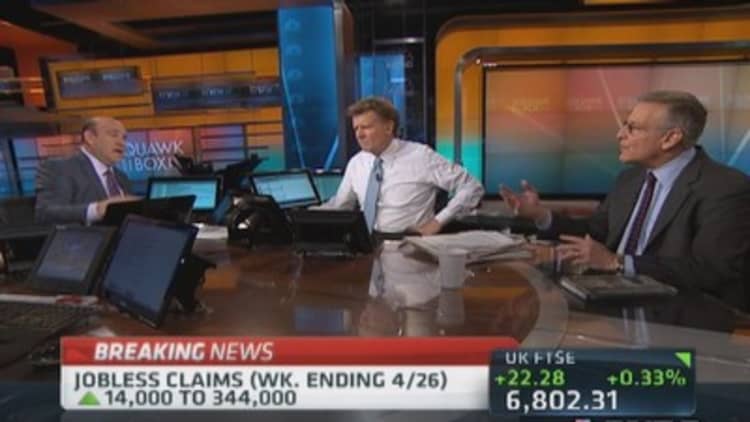The number of Americans filing new claims for unemployment benefits unexpectedly rose last week, but the underlying trend continued to point to improving labor market conditions.
Initial claims for state unemployment benefits increased 14,000 to a seasonally adjusted 344,000 for the week ended April 26, the Labor Department said on Thursday. That was the highest level since February.
Claims for the week ended April 19 were revised to show 1,000 more applications received than previously reported. Economists polled by Reuters had forecast first-time applications for jobless benefits falling to 319,000.
Read MoreWhy the slowdown in US economy may be temporary
Claims are volatile around this time of the year because the timing of the Easter and Passover holidays and school spring breaks makes it difficult to adjust for seasonal fluctuations.
The four-week moving average for new claims, considered a better measure of underlying labor market conditions as it irons out week-to-week volatility, rose only 3,000 to 320,000.

A Labor Department analyst said there were no special factors influencing the state level data.
The claims data has no bearing on Friday's April employment report, as it falls outside the survey period.
The government is expected to report that nonfarm payrolls increased by 210,000 last month after rising by 192,000 in March, according to a Reuters survey of economists.
Read MorePlanned layoffs jump 17% in April: Challenger
The unemployment rate is forecast falling one-tenth of a percentage point to 6.6 percent.
The claims report showed the number of people still receiving benefits after an initial week of aid increased 97,000 to 2.77 million in the week ended April 19.
Spending rises
In a separate report, U.S. consumer spending recorded its largest increase in more than four and a half years in March, cementing views the economy ended a dismal first-quarter on solid footing.
The Commerce Department said that consumer spending increased 0.9 percent after rising by a revised 0.5 percent in February. March's gain was the biggest since August 2009. Spending was previously reported to have increased 0.3 in February.
Economists polled by Reuters had forecast consumer spending, which accounts for more than two-thirds of U.S. economic activity, rising 0.6 percent in March.
Read MoreUS private job creation booms in April: ADP
The report added to data ranging from employment to industrial production in suggesting there was momentum in the economy at the tail end of a very difficult first quarter, which provides a springboard for faster growth in the April-June period.
The economy grew at an only 0.1 percent annual rate in the first three months of the year. Economists and Federal Reserve officials, however, pinned the slowdown on the impact of a brutal winter. A moderation in the pace of restocking by businesses, which is likely temporary, also weighed on growth.
In March, consumer spending was buoyed by a 1.4 percent surge in goods purchases. Spending on durable goods rose 2.7 percent, the largest increase since March 2010. Spending on services also increased by a solid 0.7 percent, reflecting increased demand for utilities and health care services.
When adjusted for inflation, consumer spending increased 0.7 percent in March after advancing 0.4 percent in February. March's increase in so-called real consumer spending was also the largest since August 2009.
The data were included in the first-quarter gross domestic product report, which was published on Wednesday.
Read MoreYikes! US economy crawls in first quarter
Income increased 0.5 percent in March, the biggest gain since August, after rising 0.4 percent in February.
Income continues to be supported by government subsidies for health care payments. Income at the disposal of households after adjusting for inflation and taxes rose 0.3 percent after rising by the same amount in February.
With spending outpacing income growth, the saving rate, which is the percentage of disposable income households are socking away, fell to 3.8 percent in March from 4.2 percent in February. The March saving rate was the smallest since January 2013.
—By Reuters

